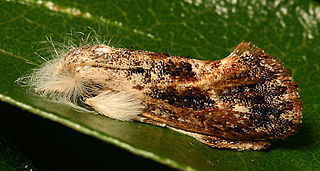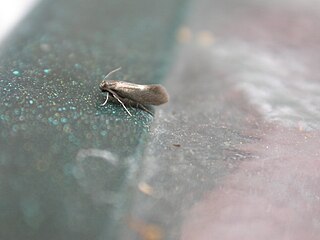Related Research Articles

Atteva is a genus of moths in the monotypic family Attevidae. The group has a pantropical distribution; however, the range of at least one species, Atteva aurea, extends into the temperate zone. No consistent hypotheses regarding the relationships, placement, and ranking of Attevidae have been published, but the prevalent view is that they likely form a monophyletic group within the Yponomeutoidea.

Yponomeutoidea is a superfamily of ermine moths and relatives. There are about 1,800 species of Yponomeutoids worldwide, most of them known to come from temperate regions. This superfamily is one of the earliest groups to evolve external feeding and to colonize herbs in addition to shrubs and trees.

Douglasiidae is a small Lepidopteran family including around 28 species of micromoth whose adults are collectively called Douglas moths. The largest genus in the family is Tinagma. They are primarily found in the Palearctic and Nearctic realms. The adults have a 6 to 15 mm wingspan, with a reduced hindwing venation and long fringes. The larvae are leaf miners or borers, primarily in stems and petioles, belonging to Boraginaceae, Labiatae, and Rosaceae.

Acrolophidae is a family of moths in the order Lepidoptera. The family comprises the burrowing webworm moths and tube moths. The family holds about 300 species in five genera, which occur in the wild only in the New World. It is closely related to the Tineidae family.

Choreutidae, or metalmark moths, are a family of insects in the lepidopteran order whose relationships have been long disputed. It was placed previously in the superfamily Yponomeutoidea in family Glyphipterigidae and in superfamily Sesioidea. It is now considered to represent its own superfamily. The relationship of the family to the other lineages in the group "Apoditrysia" need a new assessment, especially with new molecular data.

The Lacturidae comprise a family of moths in the superfamily Zygaenoidea. Brightly coloured tropical moths, the Lacturidae have been previously placed in the Plutellidae, Yponomeutidae, and Hyponomeutidae.

Brachodidae is a family of day-flying moths, commonly known as little bear moths, which contains about 135 species distributed around much of the world. The relationships and status of the presently included genera are not well understood.

Urodidae or "false burnet moths" is a family of moths in the lepidopteran order. It is the type genus in the superfamily, Urodoidea, with three genera, one of which, Wockia, occurs in Europe.

A family of primitive monotrysian moths in the order Lepidoptera, Heliozelidae are small, metallic day-flying moths with shiny smooth heads. In Europe the small adult moths are seldom noticed as they fly quite early in the spring. The larvae are leaf miners and the vacated leaf mines are distinctive because the larva leaves a large hole at the end.
Torodora is a genus of moths in the family Lecithoceridae. The genus was erected by Edward Meyrick in 1894.

Praydidae is a family of false ermine moths in the superfamily Yponomeutoidea. Though once considered a subfamily (Praydinae), a 2013 molecular analysis elevated it to family rank.

Ypsolopha is a genus of moths of the family Ypsolophidae. It is the type genus of the family and comprises over 120 described species.

Sthenopis pretiosus, the gold-spotted ghost moth, is a species of moth of the family Hepialidae. It was first described by Gottlieb August Wilhelm Herrich-Schäffer in 1856. It can be found in found Brazil, Venezuela and in the eastern United States and south-eastern Canada.
Cotaena mediana is a species of sedge moth, and for a long time the only species in the genus Cotaena. It was described by Francis Walker in 1864. It is widespread throughout the Amazon, including Brazil.
Cotaena is a genus of sedge moths originally described by Francis Walker in 1865.
Hyalorista opalizalis is a pyraloid moth in the subfamily Pyraustinae of the family Crambidae. It was described in 1854 by the French entomologist Achille Guenée based on two male and two female adult specimens collected in Brazil.
Patania silicalis, the herbivorous pleuroptya moth, is a moth in the subfamily Spilomelinae of the family Crambidae. It was described by Achille Guenée in 1854. It is found in Brazil, Venezuela, Ecuador, French Guiana, Guyana, Guatemala, Costa Rica, Panama, Mexico, Cuba, Jamaica, Puerto Rico, Hispaniola and North America, where it has been recorded from Missouri, Michigan, Ohio and New York, south to Florida.
Lepidozonates is a genus of moths in the family Lecithoceridae.
Cotaena tchalla is a species of sedge moth in the genus Cotaena. It was described by Jae-Cheon Sohn and John B. Heppner in 2015. It is found in Rio de Janeiro, Brazil.

Lirimiris auriflua is a moth of the family Notodontidae. It was first described by German entomologist Max Wilhelm Karl Draudt in 1932. It has been reported in Costa Rica, Paraguay, Argentina, Brazil and Peru. It is one of the species of Lepidoptera in which brachyptery is known to occur.